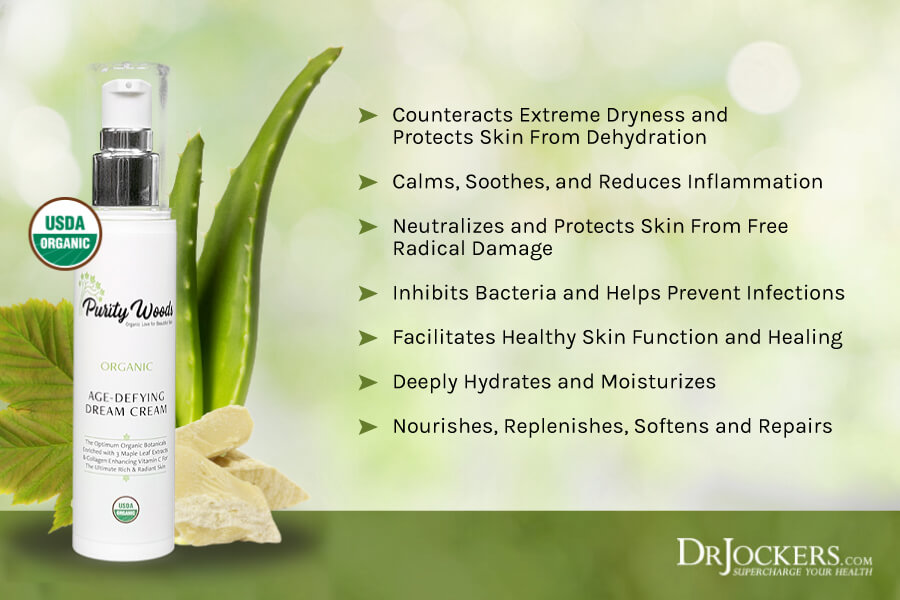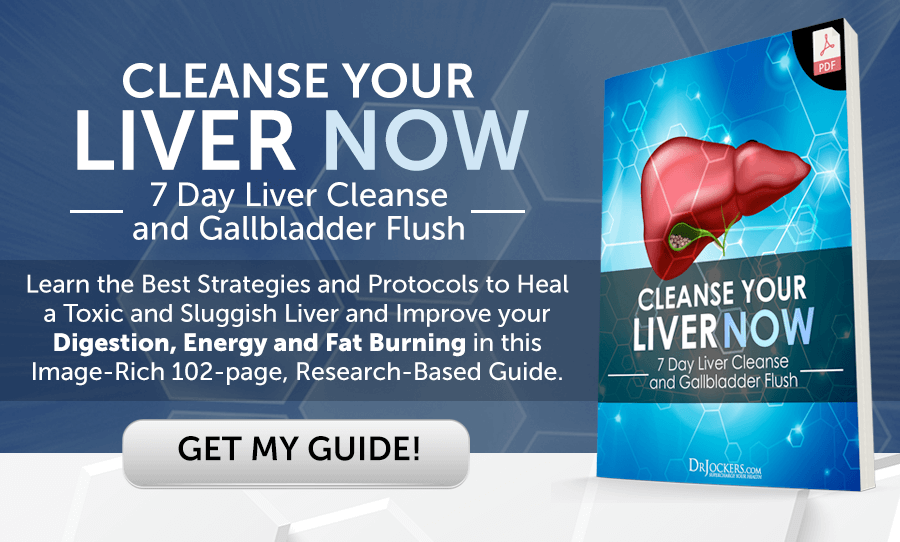 The 8 Best Ingredients for Healthy Skin (and 8 Worst!)
The 8 Best Ingredients for Healthy Skin (and 8 Worst!)
There’s no doubt that good nutrition is essential for good health. However, there’s one aspect of this that frequently gets overlooked: skin nutrition.
On the one hand, what you feed your body absolutely has an impact on your complexion. Plenty of whole foods packed with vitamins, minerals, antioxidants, and healthy fats are the essential building blocks of young, healthy skin.
But what many people don’t realize is that the opposite is also true.
What you “feed” your skin through topical products has a huge impact on both the integrity and youthfulness of your skin health as well as your physical health. Skincare can naturally promote a clear, glowing complexion, or it can degrade your skin’s natural barrier, accelerate aging, and introduce numerous toxins to your body.
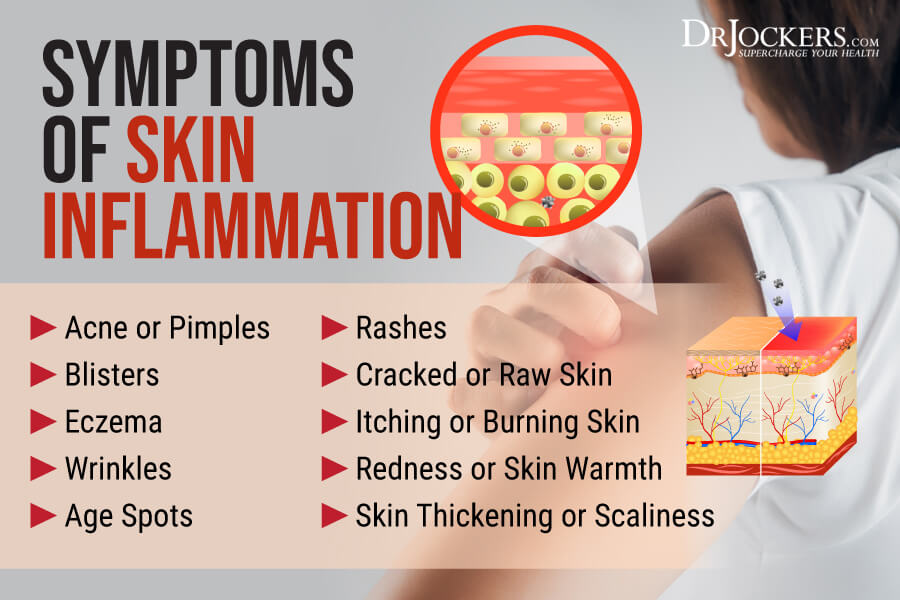
How Important is Clean Skincare?
There is much more awareness now of how important clean eating is. Choosing healthy, organic foods whenever possible supplies your body with life-giving nutrients and minimizes the amount of harmful chemicals you consume.
However, food is not the only way toxins can enter your body. Anything that you apply to your skin has the potential to be absorbed and enter your bloodstream. Whether or not this happens depends on several factors, including how large the molecules are, how long they are in contact with your skin, etc.
Unfortunately, many of the most common toxins found in mainstream skincare products are indeed small and easily absorbed. Worse, these chemicals are very difficult to avoid unless you are deliberately intentional about it. In fact, experts estimate that women apply around 168 chemicals every day through skincare products alone (and men around 85) (1).
This includes potential carcinogens, hormone disruptors, and chemicals that may cause skin allergies and irritation. Not only can these toxins wreak havoc on your health, but they can (ironically) be bad news for your skin as well, contributing to early aging. When chemicals are applied to the skin, it takes as little as 26 seconds for them to penetrate the skin barrier and get into the bloodstream.
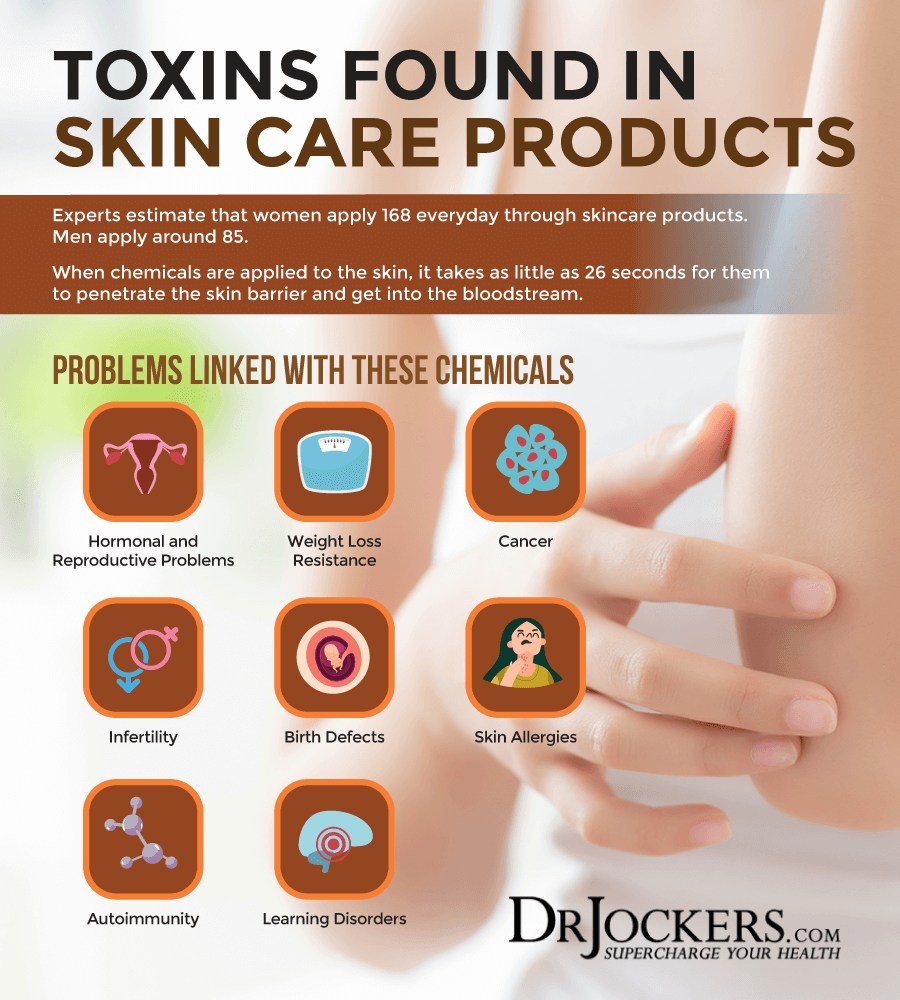
8 Skincare Ingredients to Avoid
Around 1400 chemicals are banned in the European Union (EU) and other countries—but not the U.S.— due to concerns over toxicity (2). Many of these chemicals are in products that are marketed for skin health.
This means Americans, in particular, have to read ingredient labels themselves to find truly clean skincare products. With that in mind, here are 8 of the most common “worst-offender” chemicals to watch out for:
1. Fragrance
Watch for this catch-all term, “fragrance” (or sometimes “scent” or “parfum”) on labels because it could mean any number of over 3000 possible fragrance chemicals. None of them has to be revealed to you, the consumer, as they are considered a “trade secret.”
And many are, indeed, petroleum-derived and may be allergy triggers, endocrine disruptors, carcinogens, neurotoxins, and the list goes on (3, 4).
2. Parabens
Parabens are a type of preservative that mimics estrogen in your body. They are linked to a number of health problems, particularly hormone disruption, and have the potential to increase breast cancer risk. Watch out for variations like methylparaben, butylparaben, and propylparaben (5, 6).
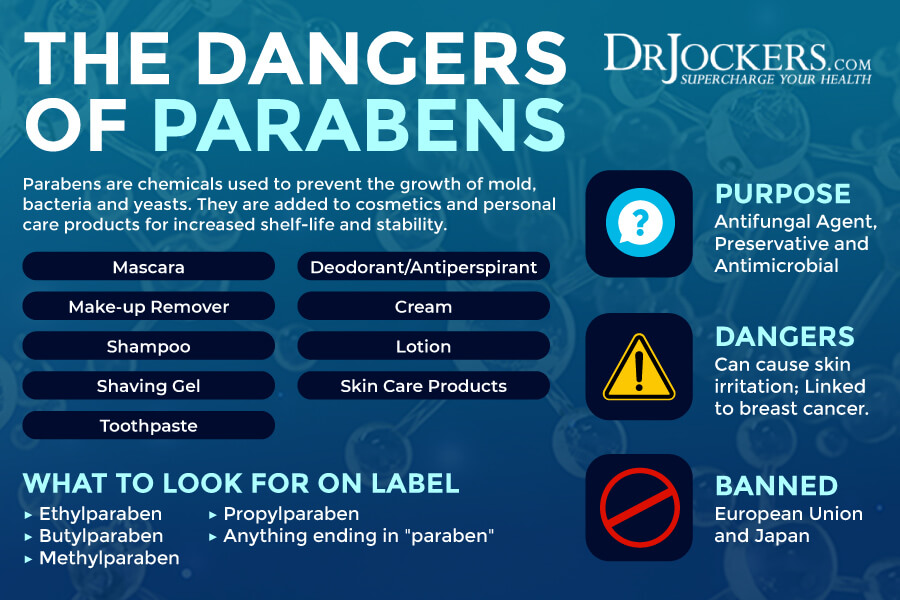
3. Phthalates
Phthalates are a group of chemicals used to make plastic more flexible. They are also used in skincare products to help them stick to the skin and make them more liquid-like. Unfortunately, they are linked to reproductive toxicity, asthma, developmental issues, birth defects, and numerous other problems (7, 8, 9).
4. Formaldehyde-Releasing Preservatives
You may not see formaldehyde on the label of your skincare products, but this known carcinogen, lung irritant, and skin irritant can be released in small amounts by certain preservatives. Especially look out for quaternium-15, DMDM hydantoin, bronopol, sodium hydroxymethylglycinate, and anything with the word “urea” in it (10).
5. Sulfates
Sulfates can be added to products as a foaming agent or a thickener. The most common is sodium lauryl sulfate (SLS), which is linked to skin irritation, ulcers, and organ toxicity. Sodium laureth sulfate (SLES) is frequently marketed as a green alternative to SLS, but it’s often contaminated with ethylene oxide and/or 1,4-dioxane—two carcinogens (11, 12, 13).
6. Polyethylene Glycol (PEG) Compounds
Polyethylene glycol (PEG) is an ingredient commonly derived from petroleum (aka crude oil), commonly used in skincare and hair color products as thickeners, softeners, and solvents. They help enhance the absorption of ingredients into the skin, including the harmful ones.
Like SLES, PEG compounds are frequently contaminated with the known and potential carcinogens ethylene oxide and 1,4-dioxane. At least one study also indicates that PEG could cause genotoxicity, which may lead to cancer (14, 15).
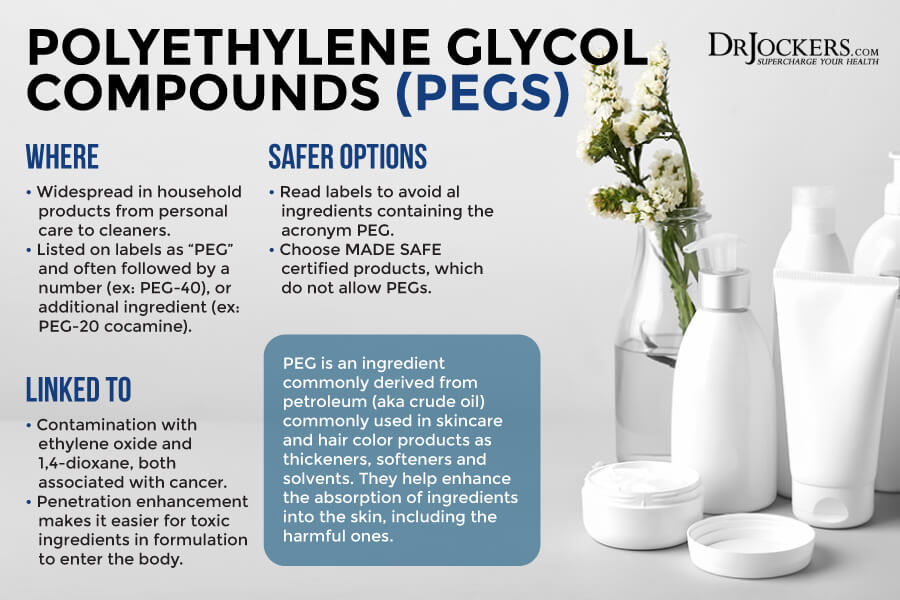
7. Diethanolamine (DEA)
Diethanolamine (DEA) is a chemical that adds foaminess or creaminess to products like cleansers and moisturizers. It may cause skin irritation and is a potential carcinogen, with some animal studies showing increased kidney and liver tumors with topical use of DEA.
Also, watch out for other ethanolamines, particularly monoethanolamide (MEA) and triethanolamine (TEA) (16).
8. Pesticides
In the same way that food can be contaminated with pesticides, natural skincare ingredients that are conventionally grown may also contain pesticide residue. Pesticides are increasingly linked to numerous health issues like cancer, hormone disruption, organ toxicity, neurological problems, and more (17).
You do not want these toxins on your skin or being absorbed into your body. The only way to avoid them completely is by using USDA Certified Organic skincare products.

Top 8 Anti-Aging Ingredients for Healthy Skin
Not only are skincare toxins bad for your health, they also make your skin look older than it is, particularly by stimulating the production of free radicals that contribute to the skin aging process (18).
The good news is that your skin is incredibly receptive to positive change. If you exchange toxic ingredients for powerful, natural options, your skin will start looking and feeling younger and healthier. To that end, here are 8 of the top natural anti-aging ingredients (countdown style) to start looking for in clean skincare products.
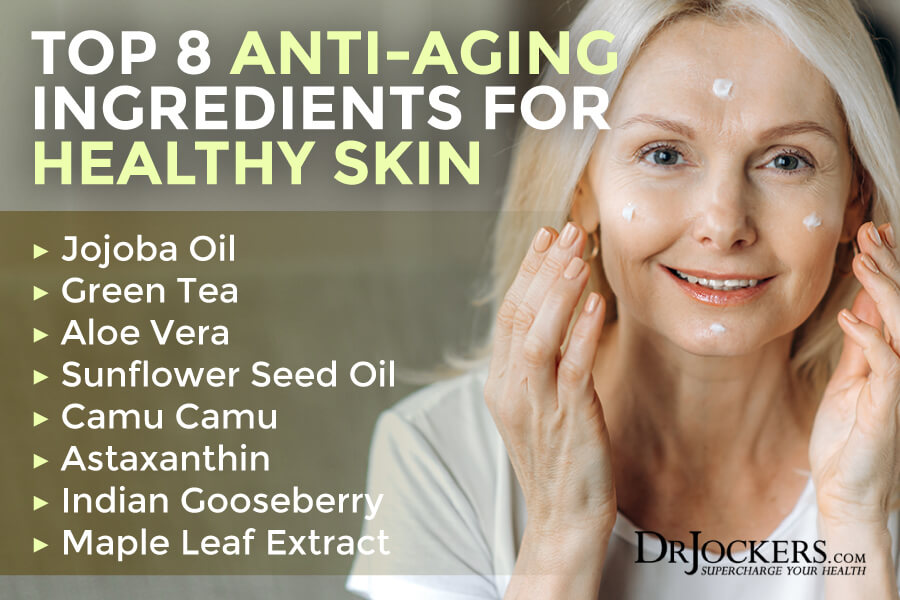
8. Jojoba Oil (Simmondsia chinensis)
Jojoba (pronounced ho-ho-ba) is an incredibly unique oil. Technically, it’s not an oil at all but rather a liquid wax ester that was once prized by Native American tribes who used it for wounds and damaged skin.
What makes jojoba oil so outstanding for skincare is that it has a makeup that is almost identical to human sebum. This allows it to deeply moisturize skin (without clogging pores), balance oil production, and strengthen your skin’s natural barrier (19).
Jojoba oil is also rich in vitamin E, an anti-aging antioxidant that helps protect your skin from photodamage (a major age-accelerator), keeping the appearance of wrinkles, fine lines, dark spots, etc., at bay for longer (20).

7. Green Tea (Camellia sinensis)
Green tea is one of the healthiest beverages you can drink and is also very potent when it comes to skincare. This is mostly due to the superpowered antioxidant it contains, known as epigallocatechin gallate (EGCG).
EGCG has been shown to reduce inflammation and protect cells from free radical damage, which is incredibly important for slowing the aging process in your skin (21).
Even more impressively, green tea extract has demonstrated the potential to delay collagen aging. This could be a huge finding because collagen is a very important anti-aging protein that keeps skin looking plump, thick, and wrinkle-free, but naturally declines in your body with age (22).
As a bonus, the antioxidants and chlorophyll in green tea may fade the appearance of wrinkles, improve skin elasticity, and overall skin health (23).
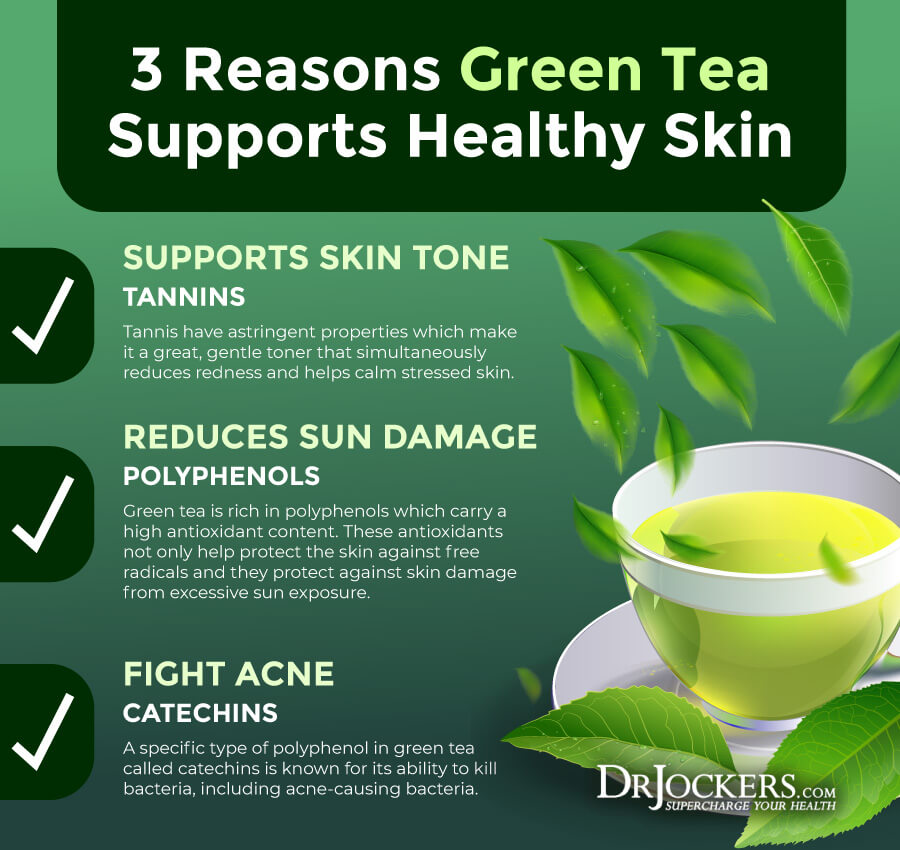
6. Aloe Vera (Aloe barbadensis)
Aloe vera has likely been used for skincare for thousands of years. The juice or gel of the thick leaves is about 98-99% water and contains over 130 plant compounds as well as numerous vitamins, minerals, antioxidants, enzymes, and amino acids (24).
When applied to your skin, aloe has a well-known soothing effect that helps damaged or burned skin. It also hydrates skin and keeps moisture locked in (rather than evaporating) because of the mucopolysaccharides—a type of sugar—present in the gel (25, 26).
In addition, aloe vera has lesser-known anti-aging effects. It may help to boost collagen and diminish the appearance of wrinkles with both internal and topical use. Aloe has even shown potential for fading the appearance of dark spots and improving skin elasticity! (27, 28, 29)
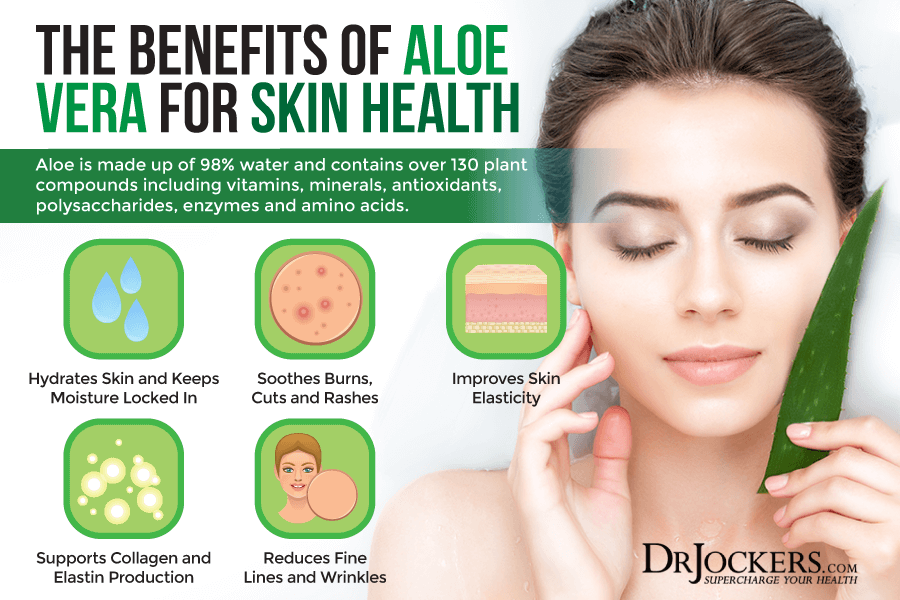
5. Sunflower Seed Oil (Helianthus annuus)
Sunflower seed oil is one of the best ingredients for enhancing skin barrier function and creating healthy skin.
In short, your skin barrier is a protective layer of dead skin cells, known as corneocytes, and lipids, which are natural fats. A healthy skin barrier is critical for keeping moisture in your skin and maintaining a smooth, even complexion.
Sunflower seed oil is full of fatty acids, particularly a highly beneficial one known as linoleic acid, that “reinforce” the lipid layer of your skin and fill in any gaps to smooth out dry, flaky skin. In fact, studies have shown that sunflower oil improves skin barrier integrity more so than olive oil (30).
Along with its skin barrier-enhancing effects, sunflower seed oil is also rich in protective vitamin E that helps to ward off damage and accelerated aging caused by overexposure to UV rays (31).
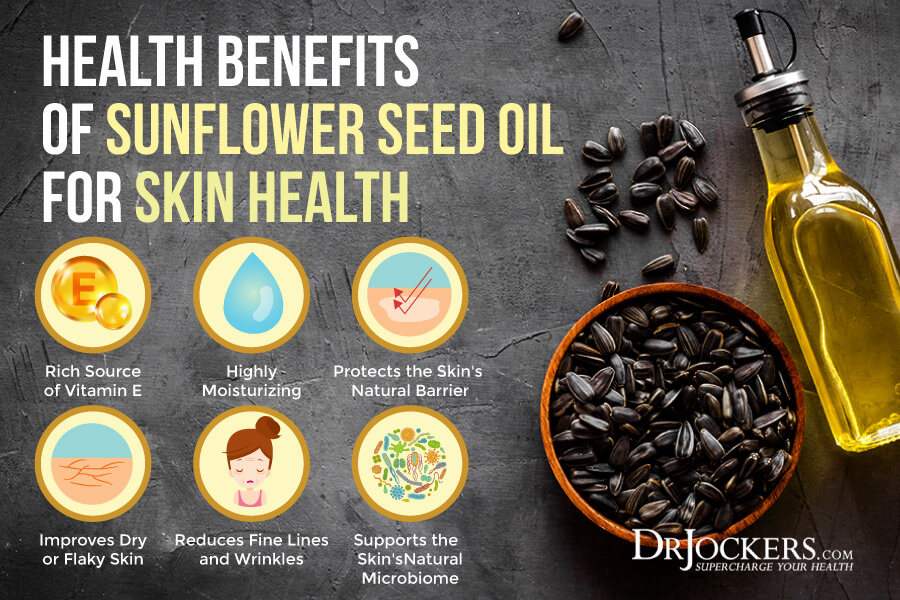
4. Camu Camu (Myrciaria dubia)
Camu camu is a small berry-like fruit native to the Amazon rainforest and lowlands. It’s one of the best sources of vitamin C in the world, with about 30-60 times the amount found in oranges!
This super high vitamin C content is one of the reasons camu camu is an excellent anti-aging skincare ingredient. Vitamin C is a natural collagen booster that helps to fend off the appearance of fine lines and wrinkles while fading the appearance of dark spots (32, 33).
Camu camu also contains a range of antioxidants (including vitamin C, of course) that may have an anti-inflammatory effect on skin and help protect it from both UV and free radical damage (34).

3. Astaxanthin
Astaxanthin is one of the most powerful antioxidants for healthy skin, although many people have never heard of it. It belongs to a larger group of antioxidants known as carotenoids that double as red, yellow, and orange plant pigments.
Not only has astaxanthin shown itself to be more powerful than other carotenoids like lutein and beta-carotene, but it’s also believed to be up to 500 times more effective than vitamin E and possibly 6000 times more potent than vitamin C! (35)
This antioxidant power translates directly to skincare with studies showing that it provides protection against UV damage that makes skin look “weathered,” diminishes the appearance of wrinkles and age spots, and improves skin elasticity (36, 37).
Astaxanthin is mostly sourced from specific types of red algae and concentrated into a powerful extract.
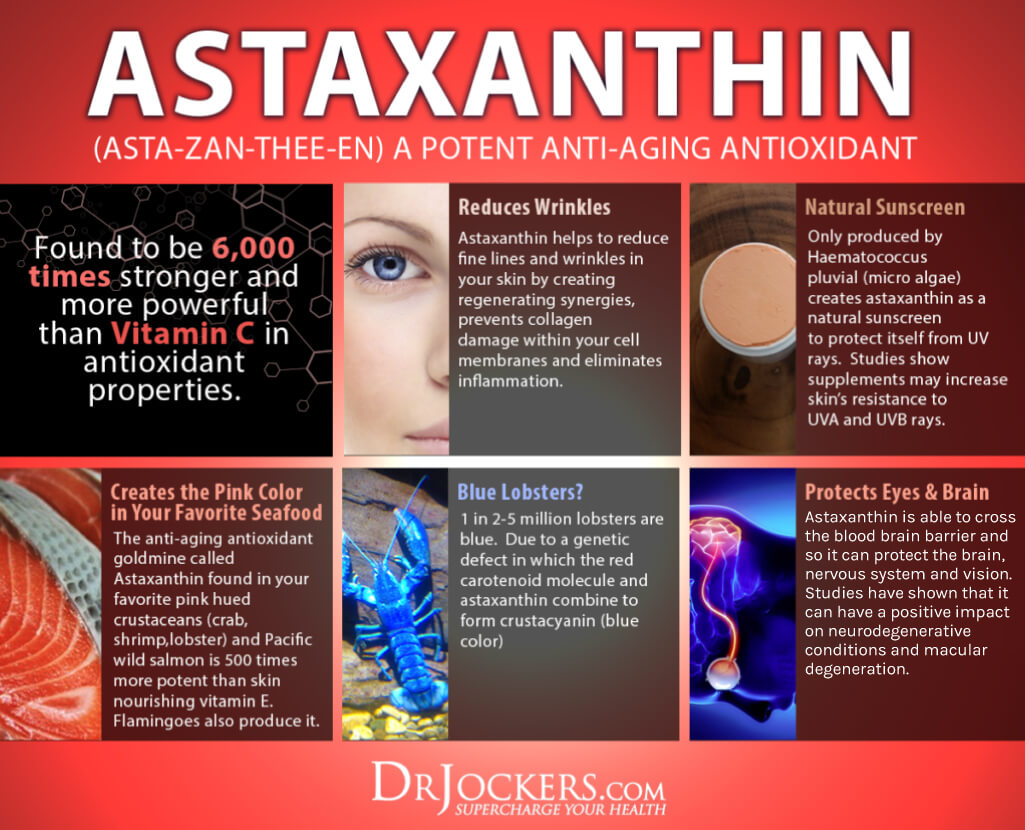
2. Indian Gooseberry (Phyllanthus emblica)
Indian gooseberry, also known as amla, is a staple in Ayurvedic medicine. It’s considered a rejuvenator and a longevity-promoter and is a key ingredient in the revered formula known as triphala.
“Rejuvenator” is a good word to describe the anti-aging skincare effects of Indian gooseberry as well. The fruits are packed full of vitamin C and are one of the richest antioxidant foods on earth, far surpassing blueberries and all but two other food sources.
This potent combination promotes collagen synthesis, helps to neutralize free radicals, and provides protection against UV radiation that contributes to the appearance of wrinkles, dark spots, and other signs of aging (38). Indian gooseberry also brightens skin’s appearance, helping to restore your natural glow, and evens out skin tone.
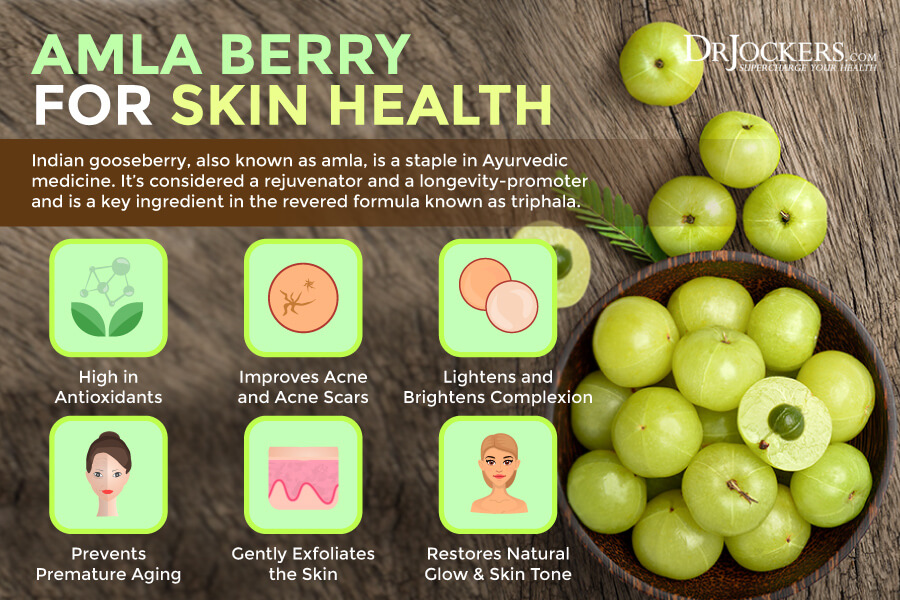
1. Maple Leaf Extract (Acer spp.)
Maple leaves bring beautiful color to the autumn months and have recently shown fountain-of-youth-like effects for your skin, mainly because of their elastin-boosting properties.
Along with collagen, elastin is one of the most critical anti-aging skin proteins. When it starts to degrade (which happens as you age), skin increasingly looks wrinkled, saggy, and generally old. This happens mainly because an enzyme known as elastase breaks down elastin over time.
Just a few years ago, researchers discovered that red maple leaf extract contains compounds called glucitol-core-containing gallotannins (GCGs) that may actually inhibit the activity of elastase, the enzyme that degrades elastin (39).
This means that maple leaf extract could be the best skincare ingredient for protecting the precious elastin in your skin and keeping it looking younger for longer.
Similar studies have also shown that maple leaf extract possesses protective antioxidant properties, supports healthy inflammation levels in skin, and may reduce the appearance of hyperpigmentation (dark spots) (40).
In fact, the researchers were so excited about maple leaf extract that one dubbed it a potential “plant-based Botox” that would work as a “topical application, not an injected toxin”!
Clean Skincare for Younger-Looking Healthy Skin
The bottom line when it comes to youthful-looking, healthy skin is this: What you “feed” your skin through topically applied products is just as important as the nutrients you supply it via the actual foods you eat.
If you are searching for truly clean anti-aging skincare that feeds your skin the “right stuff,” you’ll definitely want to consider the Age-Defying Dream Cream from Purity Woods. You can save up to 31% on this formula with our special link here.
The Age-Defying Dream Cream provides the most potent natural ingredients for younger-looking, healthy skin, including three different maple leaf extracts, hydrating sunflower seed oil, and antioxidant-packed Indian gooseberry.
It has zero toxins, synthetic ingredients, or artificial anything—all ensured by a USDA Certified Organic and cruelty-free formula that is never tested on animals.
If you want healthy skin that leaves you looking younger and you want it 100% clean, learn more about the Age-Defying Dream Cream here.

